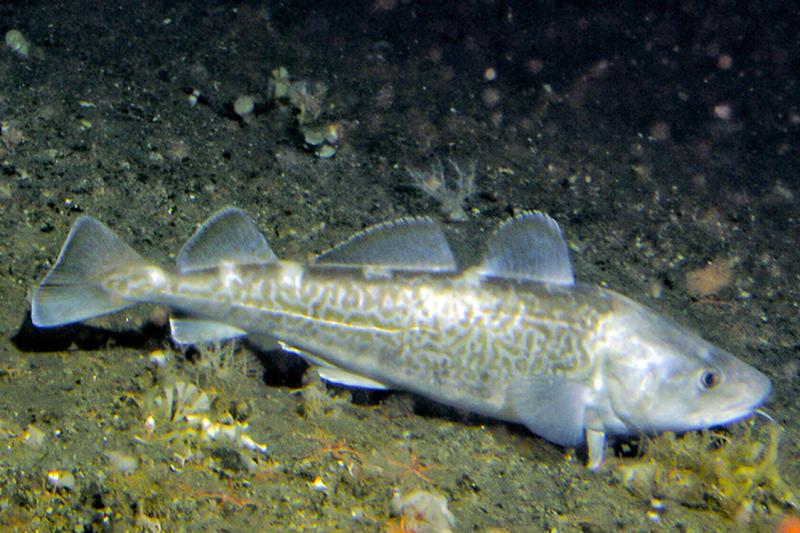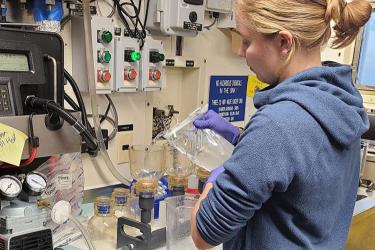In the wake of recent warming, Pacific cod expanded their summer range into the northern Bering Sea. But whether they could successfully reproduce there remained unknown.
“We know adults are moving northward, but what does that mean for other life stages?” asked study lead Jennifer Bigman, NOAA Fisheries Alaska Fisheries Science Center.
New collaborative research predicts how thermally suitable habitat for Pacific cod spawning in the Bering Sea may shift over the coming century of climate change. The study coupled state-of-the-art climate modeling with data from laboratory experiments relating hatch success to temperature. It then looked at how changes in spawning habitat might affect Pacific cod productivity.
The results project that suitable spawning habitat will expand and shift over the century. Current spawning hotspots will likely become too warm for egg development and hatching. However, the northern Bering Sea will remain too cold for successful spawning even by the end of the century.
“Understanding how warming will affect spawning habitat is a critical step in predicting and mitigating the effects of climate change on Pacific cod populations and fisheries,” said Bigman.
By integrating physiological data with climate modeling, the research provides insight into how climate might drive change.
“This approach gives us a deeper understanding of how climate change might impact our oceans and fisheries,” said coauthor and colleague Lauren Rogers. “That knowledge enables more accurate predictions of ecosystem change to help build climate-ready Alaska communities.”
Pacific Cod in Warming Alaska Waters
Laboratory experiments have shown that Pacific cod eggs have a very narrow thermal window for successful development and hatching. Juveniles and adults tolerate a much wider temperature range. The egg stage may act as a bottleneck for the species’ ability to adapt to warming.
Recent studies linked reduced thermal spawning habitat with a stark decline in Pacific cod production in the Gulf of Alaska following an unprecedented marine heatwave in 2014–2016. But the Bering Sea is colder than the Gulf of Alaska.
“Bering Sea Pacific cod populations are currently constrained by cold rather than warm temperatures. Much of the Bering Sea is too cold for eggs to successfully hatch,” Bigman said. “We undertook this research to find out whether or when warming might affect Pacific cod populations through shifts in spawning habitat.”
Predicting Past and Future Spawning Habitat
The tight relationship between temperature and hatching success for Pacific cod offered the opportunity to use thermally suitable habitat to understand how spawning habitat varied in the past—and how it may fare in the future.
The study:
- Predicted areas of thermally suitable habitat
- Validated their findings against observations
- Looked at how availability of spawning habitat affected recruitment (the number of fish that grow to reach a size available to the fishery)
Prediction
The researchers used bottom temperature hindcasts and forecasts to predict thermally suitable spawning habitat from 1970 to 2099 under two emission scenarios. The predictions suggest that:
- Suitable spawning habitat has changed little in extent or location from 1970 to present
- In the future, suitable spawning habitat will expand and shift slightly northward and eastward—more so without climate mitigation
- Historical and current spawning habitat will be too warm for successful spawning by the end of the century
- The northern Bering Sea will remain too cold for spawning habitat through the end of the century
Validation
The researchers validated these predictions against observations of spawning adults and newly hatched larvae from surveys. The predictions matched historical and current sites of known spawning aggregations. This result confirmed that bottom temperature can successfully predict spawning habitat.
Relationship to Recruitment
The study found no correlation between the extent of spawning habitat and recruitment. “Our results suggest that thermally suitable spawning habitat has not limited the reproductive potential of Pacific cod in the eastern Bering Sea in the past—nor is it likely to in the future,” Bigman said.
Ecological and Economic Implications
However, the spatial shift in thermally suitable spawning habitat over this century could have many other potential consequences.
Realized spawning habitat—where fish actually spawn—is the confluence of many ideal conditions. Beyond temperature, these may include oxygen levels, water movement and transport, food, and refuge from predators. If spawning locations shift based on the thermal limits of eggs, new habitats may not provide other needs for survival of eggs and newly hatched larvae.
And spawning habitat is not just egg habitat. It’s also the habitat of spawning adults, at least seasonally.
“Spawning adults are targeted by the commercial fishery. Our study suggests that spawning locations may shift as temperatures warm,” Rogers said. “That could affect when, where and how people fish.”
But overall, the study findings may be cause for optimism for Pacific cod in the Bering Sea.
“Pacific cod in the Gulf of Alaska was a sad story. As it warms there, it’s less and less likely to be suitable habitat for spawning,” Rogers said. “But warming will actually increase the amount of habitat where Pacific cod can spawn and hatch in the Bering Sea. In some ways, it’s a good news story.”
“I’m learning more and more that not everything about climate change is bad. Some species are going to fare better. We don’t know for sure that that’s the case for Pacific cod—we looked at just one life stage and not realized spawning habitat,” Bigman said. “But it’s not all bad news.”
This research was a collaborative effort between NOAA Fisheries Alaska Fisheries Science Center, the University of Washington, and NOAA Pacific Marine Environmental Laboratory. It was funded by the North Pacific Research Board.







